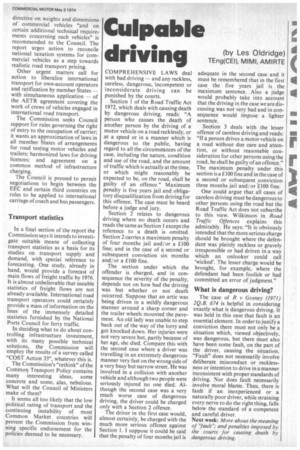Culpable driving
Page 45

If you've noticed an error in this article please click here to report it so we can fix it.
(by Les Oldridge) TEng(CEI), MIMI, AMIRTE
COMPREHENSIVE LAWS deal with bad driving — and any reckless, careless, dangerous, Incompetent or inconsiderate driving can be punished by the courts.
Section 1 of the Road Traffic Act 1972, which deals with causing death by dangerous driving, math: "A person who causes the death of another person by the driving of a motor vehicle on a road recklessly, or at a speed or in a manner which is dangerous to the public, having regard to all the circumstances of the case, including the nature, condition and use of the road, and the amount of traffic which is actually at the time, or which might reasonably be expected to be, on the road, shall be guilty of an offence." Maximum penalty is five years jail and obligatory disqualification from driving for this offence. The case must be heard before a judge and jury.
Section 2 relates to dangerous driving where no death occurs and reads the same as Section 1 except the reference to a death is omitted. Section 2 carries a maximum penalty of four months jail and/or a £100 fine; and in the case of a second or subsequent conviction six months and/or a £100 fine.
' The section under which the offender is charged, and in consequence the severity of the penalty, depends not on how bad the driving was but whether or not death occurred. Suppose that an artic was being driven in a mildly dangerous manner around a sharp corner and the trailer wheels mounted the pavement. An old lady was unable to step back out of the way of the lorry and got knocked down. Her injuries were not very severe but, partly because of her age, she died. Compare this with the second case where a driver was travelling in an extremely dangerous manner very fast on the wrong side of a very busy but narrow street. He was involved in a collision with another vehicle and although two people were seriously injured no one died. Although the second case was a very much worse case of dangerous driving, the driver could be charged only with a Section 2 offence.
The driver in the first case would, almost certainly, be charged with the much more serious offence against Section 1. I suppose it could be said that the penalty of four months jail is adequate in the second case and it must be remembered that in the first case the five years jail is the maximum sentence. Also a judge would probably take into account that the driving in the case we are discussing was not very bad and in consequence would impose a lighter sentence.
Section 3 deals with the lesser offence of careless driving and reads: "If a person drives a motor vehicle on a road without due care and attention, or without reasonable consideration for other persons using the road, he shall be guilty of an offence." The maximum penalty under this section is a £100 fine and in the case of a second or subsequent conviction three months jail and/or £100 fine.
One could argue that all cases of careless driving must be dangerous to other persons using the road but the Road Traffic Act does not subscribe to this view. Wilkinson in Road Traffic. Offences explains this admirably. He says: "It is obviously intended that the more serious charge should be brought where the defendant was plainly reckless or gravely irresponsible or had driven in a way which an onlooker could call 'wicked'. The lesser charge would be brought, for example, where the defendant had been foolish or had committed an error of judgment."
What is dangerous driving?
The case of R v Gosney (1971) 2Q. B. 674 is helpful in considering exactly what is dangerous driving. It was held in this case that fault is an essential element. In order to justifY a conviction .there must not only be a situation which, viewed objectively, was dangerous, but there must also have been some fault, on the part of the driver, causing the situation. "Fault" does not necessarily involve deliberate misconduct or recklessness or intention to drive in a manner inconsistent with proper standards of driving. Nor does fault necessarily involve moral blame. Thus, there is fault if an inexperienced or a. naturally poor driver, while straining every nerve to do the right thing, falls below the standard of a competent and careful driver.
Next week: More about the meaning of "fault"; and penalties imposed by the courts for causing death by dangerous driving.




























































































